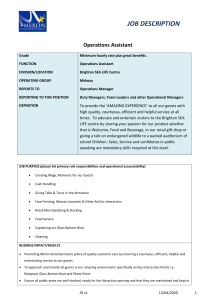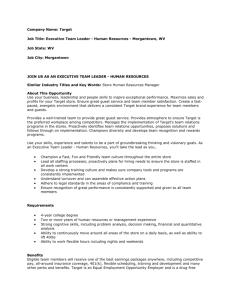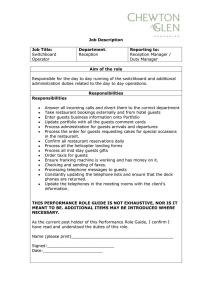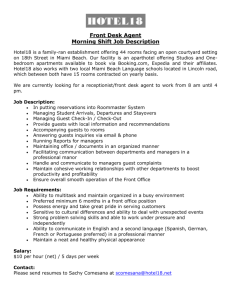The Boat Landing Guest House An Ecotourism business model
advertisement
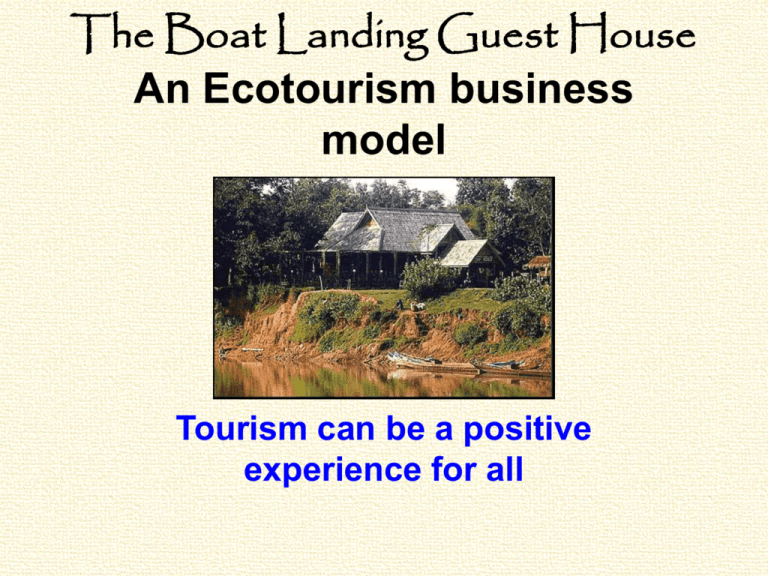
The Boat Landing Guest House An Ecotourism business model Tourism can be a positive experience for all Background • Location: Ban Khone, Luang Namtha • Opened in: November 1999 • Lao Owned Family Business • Owners: Sompawn and Patsanee Khantisouk • Built by the owners • Employees: Low season-12 High season – 17 • No. of Rooms: 10 • Total Occupancy: 26 persons The Concept • Local Atmosphere – Natural Rural setting – Traditional Style architecture – Family-run business • Local Flavor – Photos of local people – Traditional handicrafts for decoration – Genuine Village style food in the restaurant • Western Style comfort – Bright rooms with good beds – Clean Bathrooms with hot water – Quiet relaxing surroundings • Information on the area and activities available • Benefits the local people and economy Who comes? Nationalities 2004 Thai Austria Israel Singapore 1% 1% 1% 2% Irish Norwegian Italian 0% 1% Japan 2% 2% New Zealand USA 2% 17% Lao 2% Spanish 2% Denmark 2% Swiss 5% UK 15% Belgium 6% Netherlands 5% Canada 5% French 9% Australia 12% German 9% Who are they? • Mid to late career professionals • University Educated • Moderate to high income • Time poor – little time to travel • Looking for a meaningful experience with locals How many guests in a year? No. Of Guests 2002-2004 3126 2889 2547 No. of Persons 2070 1987 1639 Total 2002 Total 2003 In-house Restaurant Guests Total 2004 ua n g Pr ab an g 0% Si n Vi en g tia n H ou e ei sa U Lu do i an m g sa N i am th a C h Tr ina e N kki on n g g K hi eo N Xi U ale nk en no g K ok P wn /M ak ua T ng ha Lo ng Ph on gs P Vi ak ali en B g e Ph ng ou M kh ua ng a Kw a M Lu an g Where do they come from? Guests Arriving From 40% 35% 2000 30% 2001 25% 2002 2003 20% 2004 15% 10% 5% an g 0% Vi isa i e M ntia ua n ng e Si ng U do m sa i C h U ina nk N no on w Xi n g en K g K T hie ok r o /M ek ua kin ng g Lu Lo an ng g N am M th ua ng a Kw a N Pa ale k B en g Pa k Ph Th a Vi en ong g s Ph ali ou kh a ou e Pr ab H Lu an g Where do they go to? Next Destination of Guests 40% 35% 2000 2001 30% 2002 25% 2003 2004 20% 15% 10% 5% When do they come? Occupancy 2002 - 2004 84% 76% 76% 88% 82% 79% 76% 71% 67% 74% 69% 66% 68% 66% 62% 54% 50% 43% 39% 52% 48% 48% 51% 58% 74% 74% 74% 66% 62% 54% 44% 42% 29% 34% 29% Jan Feb Mar Apr May Jun 2002 Jul 2003 Aug 2004 Sep Oct Nov Dec What do they do? • • • • • Visit Ethnic villages Bicycle riding Boat trips Trekking Walks and market visits– observing daily life • Rafting • Bird-watching How long do they stay? Average Nights of Stay 2.64 2.41 2.14 2000 2.22 2001 2.15 2002 2003 2004 Classic Business Assumptions Profit • must make profit as quickly as possible • maximize profits in the short term • business success is measured by financial bottom line Competition • a race to beat the other guy • desire to corner the market • Only look after yourself Service • service only to paying customers The Boat Landing Ecotourism Model: There is a way to do business where everyone benefits Profit • Triple bottom line – social – environmental – financial • long term view The Boat Landing Ecotourism Model Cooperative More water in the pond makes everyone's boat rise • Work together with other businesses, service providers and gate keepers to attract business • Develop products and services not provided by others • Use products and services of others • Consciously find ways for others to participate and to benefit Service Provide services that people really need: Information, connections to businesses The Social Bottom Line: How does the local community profit? • Hire Local People – 17 of our staff come from the 4 nearby villages • Buy local goods and services – Use local craftsman and skilled labor ( carpenters, construction workers) – Serve local food – Buy local food products – Buy from local merchants – Support local handicrafts – Support local service providers – tour operations, drivers, boatmen, etc The Social Bottom Line: How does the local community profit? Local Goods and Services 76% 74% 68% 66% 57% 56% 2002 2003 Percent of Total Expenses 2004 Percent of Total Goods and Services The Social Bottom Line: How does the local community profit? Travel Philanthrophy – School fund ~ $1,500 – Black Cheeked Gibbon Fund ~ $1000 – Personal Contacts Knowledge Exchange Preservation of skills, culture and traditions ( music, clothes, building techniques) Cross-cultural understanding Environmental Bottom Line: How does the environment profit? Efficient use of Natural Resources – Solar power – Energy saving devices ( lights, switches, etc) – Water saving devices Reduced Solid Waste – Recycling – Using other materials – Composting Education – Boat Races & Clean up the World – World Wildlife Day/ Arbor Day – Educational materials for guests Networking ( WCS, Green Discovery, UNCS) Financial Bottom Line: How do we profit? Our income will exceed our expenses over the long term when we take care of the environment and the communities that our customers want to visit and provide opportunities for our customers to contribute to their welfare while having a meaningful, personal experience. How do you know that we are sincere? Certification Social Commitment Environmental Commitment Sustainibility Social Commitment • Number of locally employed staff • Percentage of Expenses entering local economy • Activities with local community organizations • Develop social sustainibility policy Environmental Commitment • Achieve best practice standards for: – – – – – Energy comsumption Use of biodegradable chemicals Reducation fo Solid waste Biodiversity conservation Water management • Environmental Policy and Action Plan How do we benefit? • The Challenge of meeting a standard – We must make a truly sincere effort • Reputation – Credibility in the market • Press Exposure What are the Challenges? • Bill’s craziness – staff appreciating the importance of this work • Collecting the data – weighing garbage • Techincal documents and English • Lack of ecolable products • Standards designed for developed countries with environmental standards Marketing: How to find the customers you want? • Build on the exisiting market – Budget travelers • Word of mouth • Gatekeepers How to really get the customers you want! • Internet, internet, internet – Go directly to your market and give them the information and contacts that they need – Sell your area and you sell yourself – Give them alternative options, then they will believe that you are not only out to get their money but providing a service • For transport • Accommodation • Activities How to guaruntee that you get the customers you want? • Give them the confidence that you will be able to provide them with the experience that they want – Be knowledgable about what want people can do – information, information, information – Get a sense of what is right for this person – Answer your email quickly and fully – Do hestitate to provide information on services from which you won’t benefit – Sincerity, sincerity, sincerity Where do we go from here? • Help communities to develop their own tourism businesses – They provide the experience, we the market – A mutually beneficial relationship • Support Luang Namtha’s #1 tourist attraction: The Nam Ha NPA – Develop different types of wilderness experiences ( bird-watching, forest stays, wildlife surveys) Come and visit us sometime! Thank You!
